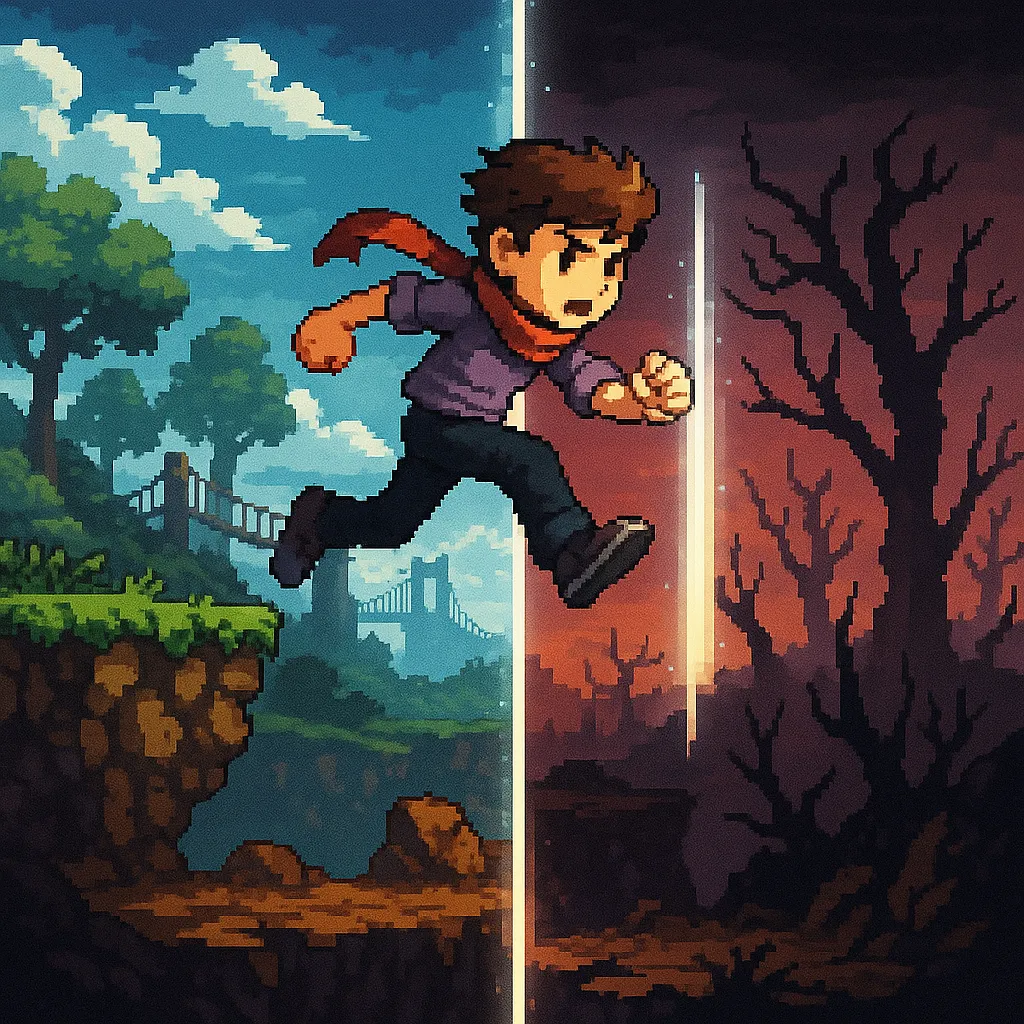Every year, a flood of 2D platformers hits the market. Most are fun, some are smart, and a rare few push the genre forward. What Lies in the Multiverse is one of those few. It doesn’t just toss players across levels — it throws them between entire realities. With a single keypress, the rules of space twist, the environment morphs, and suddenly, what seemed impossible becomes essential. This game doesn’t just make you jump — it makes you rethink what you’re jumping into.
How the Dimension-Switching Mechanic Works
In What Lies in the Multiverse, every stage has two overlapping realities. And at any moment, you’re free to jump between them. No loading. No cutscenes. Just instant transformation.
One world might be full of life — trees bloom, paths appear, gravity feels normal. Flip dimensions, and suddenly, that same forest is a chaotic mess, its structure collapsed and hostile. A bridge that looked solid may vanish, or reappear only in the alternate version. Enemies might behave differently, or disappear altogether. Even the sky might change color, as the laws of physics warp with every switch.
This seamless transition isn’t just cosmetic. It rewires how you see the level. Every puzzle is layered — and every layer matters.
Gameplay as a Rhythm Puzzle With Brains
Mastering the game isn’t just about fast fingers. It’s about sharp thinking and perfect timing.
Imagine this: You’re running toward a cliff. In your current dimension, it’s a bottomless void. But you know that in the alternate world, a platform floats exactly where you need it. Your move? Leap into the abyss — then switch dimensions mid-air — and land safely on solid ground.
That’s the kind of logic the game demands. You’re not navigating a single space. You’re playing chess on two overlapping boards, and you need to visualize both at once.
Success comes from syncing your rhythm with the world-switching mechanic. Some obstacles require lightning-fast toggling. Others ask for a pause, a breath, a rethink. The result? A game that feels less like twitchy platforming and more like dancing through a complex, moving equation.
More Than a Mechanic: When Story and Gameplay Merge
What makes What Lies in the Multiverse stand out isn’t just the clever puzzles — it’s how those puzzles serve the narrative.
Every shift between dimensions isn’t just a mechanic. It’s a metaphor. You’re not just flipping a switch — you’re seeing alternate versions of truth. Different outcomes. Forgotten paths. Lost people.
Sometimes, changing worlds reveals what could have been. A friend alive in one realm is gone in another. A town thriving here lies in ruins there. And these aren’t background details. They affect your path, your choices, and your emotional investment.
The game uses this duality to inject irony, heartbreak, and meaning into every action. It turns gameplay into storytelling — without needing a single line of dialogue.
Why It Works: Multiverse as Design, Not Gimmick
Let’s be honest: alternate realities are a hot trend. But in many games, they’re just flashy set dressing. What Lies in the Multiverse goes deeper.
Here, the shifting worlds are the spine of the experience. Every level is built around this idea. You’re not following a path — you’re building one, moment by moment. You choose the right dimension to be in, and when. You decide how the world looks and behaves at every step.
This makes the player feel like an architect of fate, not a passenger in someone else’s design. The levels aren’t just about platforming. They’re mini science experiments, each testing how logic, emotion, and cause-and-effect play out across parallel threads.
And crucially: it never gets old. Each world you encounter has its own rules, visual cues, and emotional weight. The game keeps surprising you — not by adding more mechanics, but by using the same mechanic in smarter, deeper ways.
Sample Examples of Shifting World Effects:
| Situation | World A | World B |
|---|---|---|
| Forest Path | Dead trees, broken terrain | Lush growth, dangerous vines |
| Bridge Over Chasm | Collapsed and unusable | Fully intact and stable |
| Gravity Puzzle | Normal jump physics | Low gravity, floaty mechanics |
| Enemy Behavior | Passive and predictable | Aggressive and erratic |

